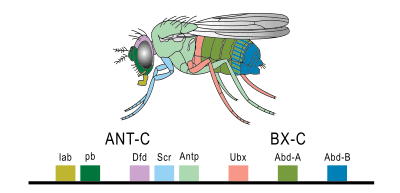''Bithorax'' complex

The Bithorax complex (BX-C) is a group of homeotic genes in Drosophila melanogaster which control the differentiation of the abdominal and posterior thoracic segments, located on chromosome III.[1] When these genes are mutated, the third thoracic segment becomes a repeat of the second thoracic segment, creating what is essentially a second thorax. This can result in a second pair of wings, a second stomach, and duplicated thoracic features in varying degrees.[2]
The complex includes the Ultrabithorax (Ubx), Abdominal A (abd-A) and Abdominal B (Abd-B) genes.[3]
Calvin Bridges discovered the Bithorax (mutation/gene) in the fly in 1915; after that, Edward B. Lewis named and worked on the Bithorax complex[4] and proposed a model in a classic evolutionary developmental biology paper in Nature in 1978, for which he won a Nobel Prize.[5]
References
- ↑ McGinnis, W.; Levine, M. S.; Hafen, E.; Kuroiwa, A.; Gehring, W. J. (1984). "A conserved DNA sequence in homoeotic genes of the Drosophila Antennapedia and bithorax complexes". Nature. 308 (5958): 428–33. doi:10.1038/308428a0. PMID 6323992.
- ↑ Dang, KD; Dutt, PB; Forsdyke, DR (1998). "Chargaff difference analysis of the bithorax complex of Drosophila melanogaster". Biochemistry and Cell Biology. 76 (1): 129–37. doi:10.1139/bcb-76-1-129. PMID 9666315.
- ↑ Developmental biology. Scott F. Gilbert
- ↑ Crow, JF; Bender, W (2004). "Edward B. Lewis, 1918-2004". Genetics. 168 (4): 1773–83. PMC 1448758. PMID 15611154.
- ↑ Lewis, E. B. (1978). "A gene complex controlling segmentation in Drosophila". Nature. 276 (5688): 565–70. doi:10.1038/276565a0. PMID 103000.